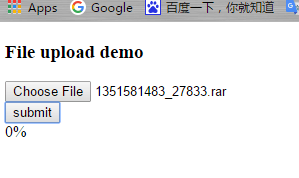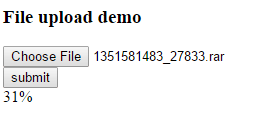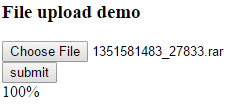很久没有更新博客了,这段时间实在的忙的不可开交,项目马上就要上线了,要修补的东西太多了。当我在学习JavaWeb文件上传的时候,我就一直有一个疑问,网站上那些博客的图片是怎么上传的,因为当提交了表单之后网页就跳转了。后来我学习到了Ajax,我知道了浏览器可以异步的发送响应,这时我又有新的疑问,那就是在我上传一些文件的时候,那些网站的上传进度是怎么做到的,因为servlet直到上传完成之后才完成响应。
最近我们的项目中有一个地方中需要用到一个功能,当用户点击一个处理按钮时,前台会实时的显示后台处理动态,由于servlet一次只能接受一个请求,而且在servlet的生命周期结束时才会把响应数据发送到前台(这一点大家可以做个这样的测试:
|
1 2 3 |
|
你们会发现前台在等待了约10s后收到了"helloworld")。所以我想到了一个方法:使用单例保存实时信息。具体的实现方法就是,当用户点击了处理按钮时,在后台开启一个线程进行处理,并且每进行到一步,就向单例中写入当前状态信息。然后编写一个servlet,用于返回单例中的信息,前台循环发送请求,这样就能实现实时显示进度的效果。
好了,啰嗦了这么多,下面进入正题,如何实现上传文件动态显示进度,其实思想和上面的功能是一致的,我将这个功能分为三个点:
1.单例:用于保存进度信息;
2.上传servlet:用于上传文件并实时写入进度;
3.进度servlet:用于读取实时进度信息;
上代码,前台:
|
1 2 3 4 5 6 7 8 9 10 11 12 13 14 15 16 17 18 19 20 21 22 23 24 25 26 27 28 29 30 31 32 33 34 35 36 37 38 39 40 41 42 43 44 45 46 47 48 49 50 51 52 53 54 55 56 57 58 59 60 61 62 63 64 65 66 67 68 69 70 |
|
后台,单例:
|
1 2 3 4 5 6 7 8 9 10 11 12 13 14 15 16 17 18 |
|
上传servlet:
|
1 2 3 4 5 6 7 8 9 10 11 12 13 14 15 16 17 18 19 20 21 22 23 24 25 26 27 28 29 30 31 32 33 34 35 36 37 38 39 40 41 42 43 44 45 46 47 48 49 50 51 52 53 54 55 56 57 58 59 60 61 62 63 64 65 66 67 68 69 70 71 72 73 74 75 76 |
|
进度servlet:
|
1 2 3 4 5 6 7 8 9 10 11 12 13 14 15 16 17 18 19 20 21 22 23 24 25 26 27 28 29 30 31 32 33 34 35 36 37 38 39 40 41 |
|
效果图:




以上就是本文的全部内容,希望对大家的学习有所帮助,也希望大家多多支持服务器之家。
原文链接:http://www.cnblogs.com/dong-xu/p/6701271.html
本文链接:https://my.lmcjl.com/post/13969.html

4 评论